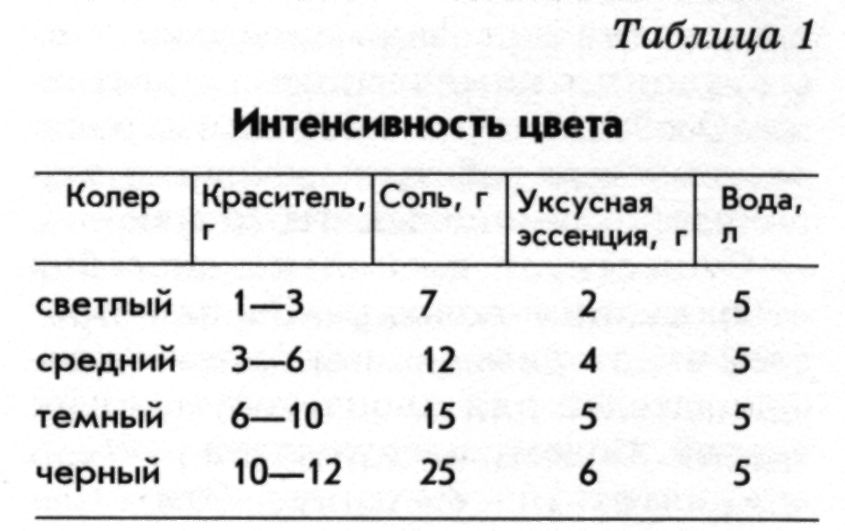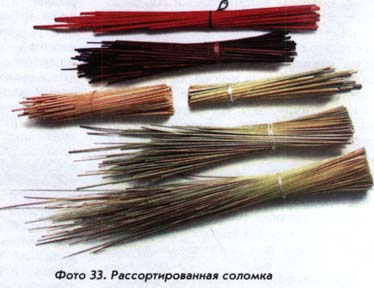Whitening. All operations on teeth whitening associated with highly-active chemicals. Particularly aggressive perhydrol, so all work should be done in rubber gloves.
There are several ways of whitening straw. The easiest with the use of household bleach for cotton fabrics. The straw immersed in the solution and boil for 15-30 minutes. These brighteners help to lighten the straw, but a significant color defect does not eliminate.
To effectively apply a 15 - or 32% solution of hydrogen peroxide (perhydrol). 1 liter of water take about 150 g of 15% perhydrol and 20 g of 20% ammonia solution (ammonia). When merging the reaction begins with the evolution of heat. The straw was placed in the solution under the load and kept therein for about 1 hour, periodically removing the load and stirring. Readiness can be defined only in appearance: straw should gain the tone desired purity. The presence of ammonia in solution gives a yellowish straw color. If bleaching is to use only a solution of perhydrol, the straw will be dull, lifeless, yellowish-white color, which has nothing to do with the natural pale Golden color, and the product will look dead. The whitening process will be accelerated if the capacity of straw to warm up, without bringing the solution to boiling. After bleaching, the straw should be rinsed thoroughly in running water or in large containers with water at least three times. The washed straw is necessary to drain and spread it in a thin layer to dry. For one piece straw bleach is better at once in the required amount, so how to get the straw in the same shade a second time will be difficult. Bleaching should be carried out in the enameled tray. After this bleaching straw acquires a uniform color, increase its plastic quality.
In a production environment 3-5 kg of bleached straw in this part: 4 liter 40% perhydrol, 18 liters of water, 140 g of ammonia, 40 g of a silicate adhesive.
If mold and mildew have damaged the straw slightly, as bleach can be used a solution of peroxide tablets. To 3 liters of water taken 18 pills and, if necessary, the concentration of peroxide can be increased.
Dyeing with natural dyes. The color composition may be based on natural tones of straw, and may require additional color accents. Straw lends itself well to dyeing both natural and chemical dyes. As natural dyes you can use onion peel, cones of alder, oak bark.
Dyeing with onion skin straw gets ocher. Their intensity and nuances depend on the concentration of onion extract and from varieties of onions. Catkins of alder and oak bark will give a straw brown shades. If you want you can experiment with other dyes that are used in the national life for dyeing yarn and fabric. The result can give the young birch leaves, grated beets and carrots. The painted straw placed between the layers of dye plants or their parts, pour water and boil on low heat for at least 20-30 minutes.
Increasing the concentration of solution and time of dyeing, it is possible to obtain a colouring of different intensity. Painted straw washed and dried.
Shades of brown can also be obtained if the calcine straw ribbon of iron or stretch it over the surface of the burner disk appliance. To receive shades of brown in the wicker products, proceed as follows: braided the required number of elements from the natural straw color, then put them into the oven and kept at low heat until the straw does not become brown required intensity. In all cases care should be taken that the straw was not burnt and brittle.
Dyeing with chemical dyes. When painting straw chemical dyes used universal aniline dyes for fabrics and soda.
The staining with aniline dyes it is possible to obtain a bright range of colors: green, orange, red, blue, purple etc.
Description of the dyeing process can be taken from the instructions included with the dyes. The average ratio of the following: 1 liter of water is taken from 1 to 12 g of dye. The amount of dye, as in all previous cases, affects the intensity of the resulting color (table).

Straw is immersed in the hot staining solution, pressed by the yoke and held at a temperature of 90— 100 "C 20-90 minutes. Sticks must be periodically stirred. The duration of the colouring effect on the intensity of the color. After dyeing the strips at least twice washed in plenty of water. At the last washing, to fix the paint, a 10-15 minute soak in a solution of vinegar: 5 liters of water two tablespoons of vinegar. The straw is allowed to drain, spread in a single layer to dry.
Dry colored straws can be stored indefinitely and used as needed. If dyeing is done at home for individual work, large amounts of dyed straw is not required. To consume the dyes and not to resort to this process, it is often convenient to paint the straw store and paint several types of straw (thin, medium, short) (photo 33). To already graded the straw when dyeing blended, bundles and did not untie, but only weaken dressings (solution would freely penetrate into the depths of the beams, and the dyeing quality will not deteriorate). In the same weakened beams should rinse the straw.

Shades of yellow, from light to intense yellow, can be obtained if heating the strips in an aqueous solution of soda. For secondary staining, take 3-4 grams of soda in 1 liter of water.
As a dye it is also possible to use a medical "green" strips will become a bright green color. The intensity of staining, as in all previous cases, depends on the concentration of the solution. For secondary staining to about 10 ml of "green stuff" in 1 litre of water. Temperature and all subsequent operations are repeated in the same sequence as in the previous recipes.
As in bleaching, all types of paint affect the structure of the straw, it becomes softer. Dunk a straw in preparing to work in room temperature water for 5-10 minutes.



